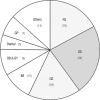Analysis of anesthesia-related medical disputes in the 2009-2014 period using the Korean Society of Anesthesiologists database
- PMID: 25653494
- PMCID: PMC4310949
- DOI: 10.3346/jkms.2015.30.2.207
Analysis of anesthesia-related medical disputes in the 2009-2014 period using the Korean Society of Anesthesiologists database
Abstract
Using the Korean Society of Anesthesiologists database of anesthesia-related medical disputes (July 2009-June 2014), causative mechanisms and injury patterns were analyzed. In total, 105 cases were analyzed. Most patients were aged < 60 yr (82.9%) and were classified as American Society of Anesthesiologists physical status ≤ II (90.5%). In 42.9% of all cases, the injuries were determined to be 'avoidable' if the appropriate standard of care had been applied. Sedation was the sec most common type of anesthesia (37.1% of all cases), following by general anesthesia. Most sedation cases (27/39, 69.2%) showed a common lack of vigilance: no pre-procedural testing (82.1%), absence of anesthesia record (89.7%), and non-use of intra-procedural monitoring (15.4%). Most sedation (92.3%) was provided simultaneously by the non-anesthesiologists who performed the procedures. After the resulting injuries were grouped into four categories (temporary, permanent/minor, permanent/major, and death), their causative mechanisms were analyzed in cases with permanent injuries (n=20) and death (n=82). A 'respiratory events' was the leading causative mechanism (56/102, 54.9%). Of these, the most common specific mechanism was hypoxia secondary to airway obstruction or respiratory depression (n=31). The sec most common damaging event was a 'cardiovascular events' (26/102, 25.5%), in which myocardial infarction was the most common specific mechanism (n=12). Our database analysis demonstrated several typical injury profiles (a lack of vigilance in seemingly safe procedures or sedation, non-compliance with the airway management guidelines, and the prevalence of myocardial infarction) and can be helpful to improve patient safety.
Keywords: Adverse Effects; Injuries; Legislation; Malpractice.
Conflict of interest statement
All of the authors have no potential conflicts of interest or financial ties to disclose.
Figures
References
-
- Cheney FW. The American Society of Anesthesiologists Closed Claims Project: what have we learned, how has it affected practice, and how will it affect practice in the future? Anesthesiology. 1999;91:552–556. - PubMed
-
- Cheney FW, Posner KL, Lee LA, Caplan RA, Domino KB. Trends in anesthesia-related death and brain damage: A closed claims analysis. Anesthesiology. 2006;105:1081–1086. - PubMed
-
- Hong SJ, Kang YJ, Jeon YH, Son JS, Song JH, Yoo CS, Kim DK. Analysis of expert consultation referrals to the Korean Society of Anesthesiologists (KSA): a comparison of procedural sedation and general anesthesia. J Anesth. 2013;27:218–223. - PubMed
-
- Posner KL, Sampson PD, Caplan RA, Ward RJ, Cheney FW. Measuring interrater reliability among multiple raters: an example of methods for nominal data. Stat Med. 1990;9:1103–1115. - PubMed
MeSH terms
LinkOut - more resources
Full Text Sources
Other Literature Sources
Medical



